#gnostic tradition
Text

Spiritual discipline is what awakens us to divine reality, not belief.
Gnosis signifies knowledge from experience. Gnosticism, as a field of study, pertains to all the ancient schools of mysteries from both East and West, whose scriptures encompass the practical science of awakening consciousness. Gnosis is not isolated to the first Christians, but permeates all times, cultures, and spaces, for while consciousness is universal, the means of expressing such experiential wisdom of the divine is temporal and idiosyncratic to the language, mentality, and needs of a particular society.
Gnosis is what we have verified through experience and experimentation, predicated upon practical methods and personal effort. It is never the product of a belief system, of adopting a religious or mystical attitude, demeanor, or behavior. It is never achieved through attendance, adherence to, or acceptance from a group, by believing in doctrine or creed. It is the flowering and natural unfolding of the soul, which is created and developed when the proper causes and conditions have been met.
Just as there are laws that govern the physical universe, so too are there spiritual laws, causes, and methods to originate the soul: the awakening of the consciousness.
Therefore, the Greek term γνῶσις gnosis is synonymous with genuine faith. Faith has nothing to do with belief, with accepting or rejecting a concept in the mind or upholding a sentiment in the heart. Faith is what we know from facts, from witnessing and understanding reality. Belief takes no effort to foster or develop, whereas the awakening of consciousness and divine experience requires tremendous discipline and the application of spiritual works.
Read or listen to the entirety of this article:
#gnosticism#gnosis#gnostic#chicago gnosis#samael aun weor#gnostic academy of chicago#gnostic tradition#gnostics#gnostic teachings#gnostic bible#gnostical#gnostic christianity#gnostic gospels#spirituality#awakening#meditation#how to meditate#meditation podcasts#spiritual podcasts#spiritual podcast#spiritual exercises#spiritual life#spiritual path#spiritual growth#spiritual journey#spiritual development#spiritual awakening#spiritual disciplines#spiritual enlightenment#spiritualgrowth
49 notes
·
View notes
Note
Is there any lore info about lucifer? I'm really curious about what he's like now/was like because in ultrakill it almost seemed like he was framed as an innocent victim of god's wrath also your AU is so cool!
thank you!! as for lucifer's lore, all we have right now is testament iv, which makes it seem as though lucifer was banished due to his questioning of god's goodness with the punishment system of hell. lucifer seems to be acting here in a role in line with the traditional "satan" who was meant to be the heavenly accuser (the book of job is the clearest depiction of this), but in this case he is challenging god's thinking as though to keep him in check as well. that's really all that can be said about him right now, and anything else is speculation at this point. for the sake of my au, my lucifer is definitely an innocent victim that had a smear campaign leveled against him by god so that none of the angels knew the true reason for his banishment. and for right now, my idea of him in hell is very much based on dante's interpretation of satan, who is so consumed by his own grief that he can no longer respond to the outside world, locked into his own personal hell forever. and man...to think of lucifer simply believing he's doing his job, questioning and opposing as he is meant to, while also following his heart which is FULL of god's love......and then his dad just evicts him immediately and slams him down into the pit until the end of time over it. i'd be crying forever too!!!
#reading lucifer as very tragic in this world#it puts me in mind of gnosticism a little#don't mind my p5 phase showing but!!! satanael opposed the demiurge's cruel treatment of humans#and was banished from his heaven for it#so it's just interesting here as lucifer seems to be siding with humans#which is. obviously not his traditional stance lol#cake answers#lucifer
28 notes
·
View notes
Photo

“The arms rotate, but the Center does not, remaining as still as the Polar axis, the unmoving mover of terrestrial movement. The unspoiled self. The number five thus symbolizes the inner man, also the total man, divine, perfect”.
- Miguel Serrano.
#Miguel Serrano#symbols#carl jung#self#inner man#divine#solar symbolism#shadow#collective unconscious#Nos#hermeticism#traditionalism#julius evola#rene guenon#kybalion#gnosticism#gnosis#hindu traditions#indo-europeans#Indo-European religions#myth#bagavad gita#Avatar
52 notes
·
View notes
Text
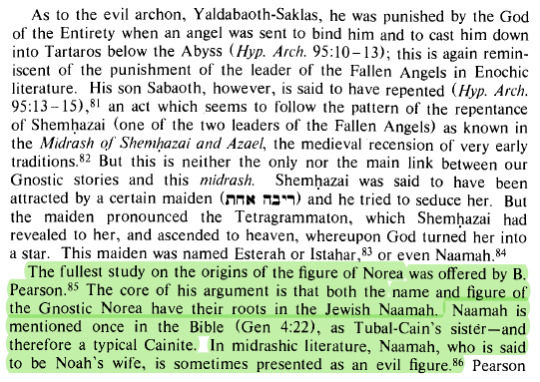


- Gedaliahu A. G. Stroumsa, Another Seed: Studies in Gnostic Mythology, 1984, pp. 56-58.
17 notes
·
View notes
Text

From 10 Problems in the Traditional Catholic Movement by Fr. Chad Ripperger
Sometimes I come across tradcats saying they don’t pray the Luminous mystery and the Divine Mercy chaplet because they’re new additions and it makes think it fits this category of being gnostic because their reasons sounds really arbitrary base on their own whims.
I did use to doubt the Divine Mercy chaplet too but I read a post by a Catholic priest refuting Eastern Orthodox objection to the Catholic Faith stating that it’s changed so it’s not true. He said that God doesn’t just bless something just because it’s old. That simple sentence really struck me and change how I view things of seeing traditional as somehow being immune to heresy. And since God is outside time, He can decide to give us new devotions to pray at a later time period instead of during the Middle Ages.
I mean, it's okay if you prefer other devotions but saying that the Luminous mysteries isn't as valid as the other mysteries doesn't seem doctrinally sound to me.
16 notes
·
View notes
Text
Raffaello
Bloganuary writing promptWrite about your first name: its meaning, significance, etymology, etc. View all responses
Today’s prompt becomes personal, asking about the origin and meaning of my name.
A Name with Divine Connections
As you know, my name is Raffaello, written in the Italian version, rich with historical resonance, and carrying a beautiful meaning that resonates with themes of…

View On WordPress
#Archangel#bloganuary#bloganuary-2024-21#Book of Tobit#dailyprompt#dailyprompt-1824#Enoch#Gnostic#gnosticism#Hebrew Bible#Islam#Islamic tradition#Israfil#name#Ophite Diagram#Raffaello#Raffaello Palandri#Raphael#Yawm al-Qiyāmah
2 notes
·
View notes
Text
If you catch me posting Bible memes I'm not turning into a Christian or whatever the fuck I was before my intense spiritual crisis 2 years ago (or was it three)? I went to school for academic theological studies (analysis of religion from an exterior view point) and recent books have me nostalgic and hyperfixating.
#if anything grief turned me back into atheist#ive been a few things#my dad was raised catholic but is a staunch atheist#and mom was sort of Pentecostal and sort of methodist and is a like#soft atheist who definitely believes in ghosts and curses and shit#and i was an atheist for a long time but i felt drawn to Catholicism#it felt like a culture idk#and then it got more and more comforting to non commitally hover at its edges through witchcraft and loose modern spiritual stuff#and perform mental gymnastics about it and mostly believe large swaths of its mythology without thinking about the moral and human side and#also not converting because i couldn’t face my parents if i did and i also was already aware that i couldn’t#but i kept convincing myself that The Church as an institution could somehow be good despite how evil everyone running it is#and then my education finally got the upper hand over my weird desperate longing to fully believe in something beautiful and nearly ancient#and also my father had repeated lies he didn’t know enough to spot#my education finally made me understand that The Church was only >1000 years old#that the gnostics (originally a jewish tradition according to bart d erhman and he referenced this as being commonly accepted)#were the group which the supposed messiah belonged to and the patristic church (catholic church 1.0) had them all killed#unarmed ascetics starving in the desert the people who wrote the earliest gospels and the church killed them all#there is no textual basis for the authority of the pope#the devil was a comprise#the saints were a marketing tactic#correction: the church is sort over a thousand years old but it went through so many iterations and eras before we got here#to be exact#the church FATHERS aka the church that will become the patristic church in the wake of these dudes#and im fuzzy on if the orthodox church is a fully separate iteration or if it and the patristic are used interchangeably#Catholicism as like a term comes out of the scism with Protestantism i think
1 note
·
View note
Video
youtube
Jung, Tolkien and the Hermeneutics of Vision -- Dr. Lance S. Owens
#youtube#Here is something fascinating#which provides a substantial point of connection between modern paganism and Christianity#the Gnostic tradition#and modern psychology.
8 notes
·
View notes
Text
Ответ без вопроса


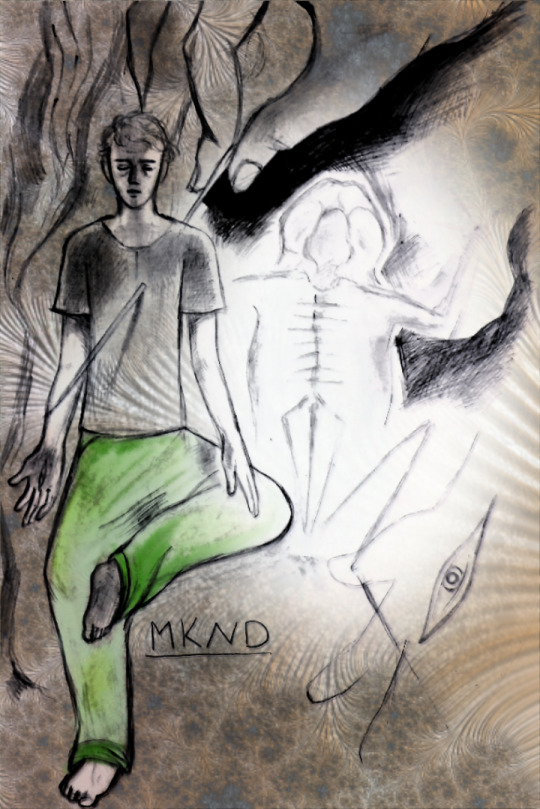
#art#artists on tumblr#drawing#sketch#my art#artwork#artist#sketchbook#арт#traditional art#contemporary art#Gnosticism#gnosis#enlightenment#Meditation#Рисунок#Скетч#Набросок
17 notes
·
View notes
Text
I love reading about older philosophies and religions we didn’t really get to cover in college-level philosophy and religion because looking back at traditional Gnosticism as someone who was raised Christian is like.
Okay so Gnostics essentially believe there is a bigger secret god behind Yahweh who is an all encompassing whole of all aspects from which divine good flows and Yahweh still exists but perhaps as a more malicious deity who created the world with intrinsic conflict and suffering. Work. Like that’s legitimately fierce.
#I really wish we knew more about gnosticism it sounds so based#the last surviving place of worship that uses traditions from antiquity is in Iraq#Which if you haven’t been living under a rock is a grim telling of what happened to the others
2 notes
·
View notes
Text
"Unveiling Eternity: Navigating Cosmic Mysteries in 'The Virgin of the World' by Hermes Mercurius Trismegistus"

"The Virgin of the World" translated by Anna Kingsford and Edward Maitland, serves as an enlightening voyage into the esoteric realms of ancient wisdom and spiritual transcendence. At its core, the book is a sacred dialogue attributed to Hermes Mercurius Trismegistus, a legendary figure in hermetic and alchemical traditions.
This esoteric masterpiece delves into the profound teachings of Hermes, offering readers a glimpse into the secrets of the universe, the divine, and the profound connection between the spiritual and material worlds. The translation by Kingsford and Maitland, known for their deep engagement with mysticism, adds a layer of accessibility to the profound wisdom embedded in the original text.
The narrative unfolds through a series of conversations, revealing the timeless wisdom that has echoed through the corridors of history. Hermes, the mythical messenger of the gods, serves as the guide through intricate philosophical concepts, unveiling the mysteries of creation, spirituality, and the divine order.
The strength of this translation lies in its ability to convey the richness of Hermes' teachings while maintaining a poetic and engaging narrative. Kingsford and Maitland's translation captures the essence of the original text, allowing readers to connect with the ancient wisdom in a meaningful way. The prose, while maintaining its mystical quality, remains accessible to modern readers, bridging the gap between antiquity and contemporary understanding.
One of the remarkable aspects of "The Virgin of the World" is its exploration of the interconnectedness of all things. The text navigates through diverse topics, including cosmogony, astrology, spiritual rebirth, and the symbolism of ancient rituals. It invites readers to contemplate the profound mysteries of existence and encourages a deeper understanding of the self in relation to the cosmos.
As the title suggests, the concept of the "Virgin" symbolizes purity, wisdom, and the untainted nature of the divine. Hermes, through these dialogues, invites readers to partake in a transformative journey, embracing the purity of spiritual enlightenment.
In conclusion, "The Virgin of the World" is a timeless exploration of metaphysical and spiritual truths. Kingsford and Maitland's translation breathes new life into this ancient text, allowing modern readers to embark on a quest for wisdom alongside the mythical Hermes. The book stands as a testament to the enduring power of hermetic philosophy and its capacity to inspire seekers of truth across the ages.
"The Virgin of the World" of Hermes Mercurius Trismegistus is available in Amazon in paperback 14.44$ and hardcover 22.22$ editions.
Length of the book: 235 pages
Language: English
Rating: ∞/10
Link of the Book!
Review By: King's Cat
#Hermeticism#Ancient Wisdom#Esoteric Knowledge#Alchemical Texts#Mystical Philosophy#Spiritual Enlightenment#Occult Tradition#Gnostic Wisdom#Sacred Feminine#Symbolic Allegory#Transcendental Insights#Divine Wisdom#Esoteric Literature#Alchemy#Cosmic Harmony
0 notes
Text

The controversial Gospel of Judas is a powerful scripture depicting the relationship between betrayal and transcendence. While religious groups intensely, fearfully, and dogmatically contest its authenticity, this scripture is clarified through a comparative study of Samael Aun Weor's writings. Just as an actor plays a part in a film and should not be condemned for it, likewise the Apostle Judas should not be denigrated for the role he played in a necessary cosmic drama led by Jesus, the Master Aberamentho. By understanding who Judas is in us, we can better understand the ways we betray our own selves while striving for divine reality.
#gnosticism#gnosis#gnostic#chicago gnosis#samael aun weor#chicago gnosis podcast#gnostic kabbalah#gnostic tradition#gnostics#gnostic bible#gnostic teachings#gnostic christianity#gnostic gospels#gnostical#samaelaunweor#judas iscariot#jesus x judas#esoteric christianity#christian faith#jesus christ#christianity#christian doctrine#christian bible#spiritual#spiritual initiation#spiritual enlightenment#temptation#mysticism#alchemy#kabbalah
27 notes
·
View notes
Text
"Unveiling Eternity: Navigating Cosmic Mysteries in 'The Virgin of the World' by Hermes Mercurius Trismegistus"
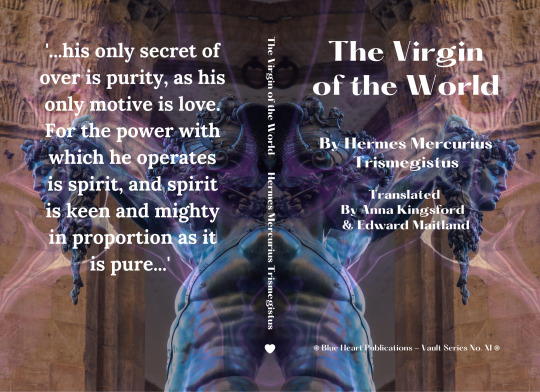
"The Virgin of the World" translated by Anna Kingsford and Edward Maitland, serves as an enlightening voyage into the esoteric realms of ancient wisdom and spiritual transcendence. At its core, the book is a sacred dialogue attributed to Hermes Mercurius Trismegistus, a legendary figure in hermetic and alchemical traditions.
This esoteric masterpiece delves into the profound teachings of Hermes, offering readers a glimpse into the secrets of the universe, the divine, and the profound connection between the spiritual and material worlds. The translation by Kingsford and Maitland, known for their deep engagement with mysticism, adds a layer of accessibility to the profound wisdom embedded in the original text.
The narrative unfolds through a series of conversations, revealing the timeless wisdom that has echoed through the corridors of history. Hermes, the mythical messenger of the gods, serves as the guide through intricate philosophical concepts, unveiling the mysteries of creation, spirituality, and the divine order.
The strength of this translation lies in its ability to convey the richness of Hermes' teachings while maintaining a poetic and engaging narrative. Kingsford and Maitland's translation captures the essence of the original text, allowing readers to connect with the ancient wisdom in a meaningful way. The prose, while maintaining its mystical quality, remains accessible to modern readers, bridging the gap between antiquity and contemporary understanding.
One of the remarkable aspects of "The Virgin of the World" is its exploration of the interconnectedness of all things. The text navigates through diverse topics, including cosmogony, astrology, spiritual rebirth, and the symbolism of ancient rituals. It invites readers to contemplate the profound mysteries of existence and encourages a deeper understanding of the self in relation to the cosmos.
As the title suggests, the concept of the "Virgin" symbolizes purity, wisdom, and the untainted nature of the divine. Hermes, through these dialogues, invites readers to partake in a transformative journey, embracing the purity of spiritual enlightenment.
In conclusion, "The Virgin of the World" is a timeless exploration of metaphysical and spiritual truths. Kingsford and Maitland's translation breathes new life into this ancient text, allowing modern readers to embark on a quest for wisdom alongside the mythical Hermes. The book stands as a testament to the enduring power of hermetic philosophy and its capacity to inspire seekers of truth across the ages.
"The Virgin of the World" of Hermes Mercurius Trismegistus is available in Amazon in paperback 14.44$ and hardcover 22.22$ editions.
Length of the book: 235 pages
Language: English
Rating: ∞/10
Link of the Book!
Review By: King's Cat
#Hermeticism#Ancient Wisdom#Esoteric Knowledge#Alchemical Texts#Mystical Philosophy#Spiritual Enlightenment#Occult Tradition#Gnostic Wisdom#Sacred Feminine#Symbolic Allegory#Transcendental Insights#Divine Wisdom#Esoteric Literature#Alchemy#Cosmic Harmony
0 notes
Text
THE DEMIURGE IS REAL
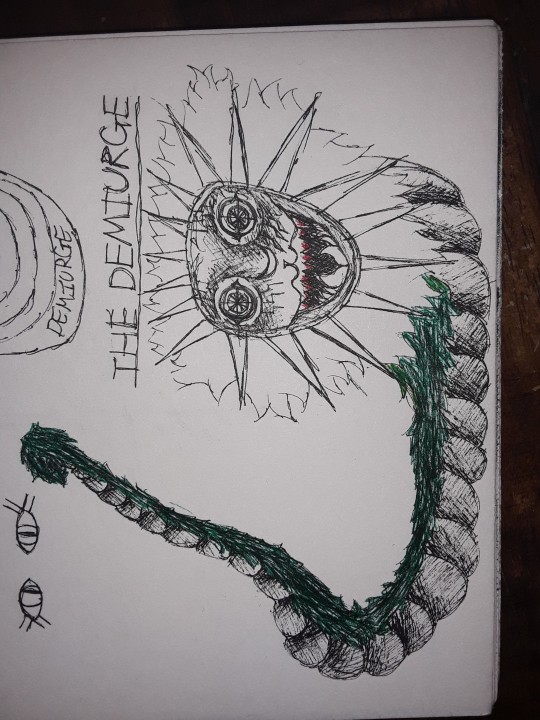
1 note
·
View note
Text
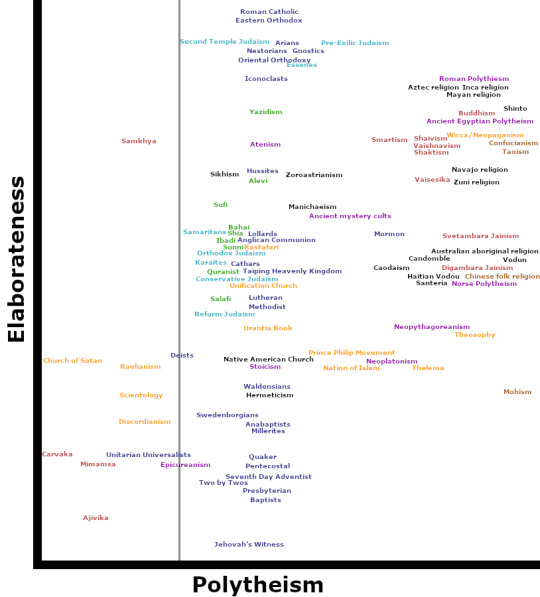
Revised version of "polytheism vs elaborateness" religion chart. I started with a list of around 150 religions, sects, denominations, philosophies, and spiritual tendencies, whittled down to 100 based on what I could find information on and what meaningful differences would actually show up in a chart like this. Dark blue is Christianity and Christian-derived tendencies; light blue is Judaism and Jewish-derived tendencies; green is Islam and Islam-influenced tendencies; purple is ancient Mediterranean polytheism and related schools of thought; red is Dharmic/Hindu-influenced schools of thought; tan is Chinese religion and philosophy; orange is new religious movements; black is other, unaffiliated religions and movements.
Obviously, "what is a religion" is a complicated topic. Some of the things on this chart might strike you more as philosophical schools (Carvaka, Stoicism), epistemological approaches (Unitarian Universalism), or different ways of slicing the same tradition. The scholarly definition of "religion" is sort of fundamentally circular, and that's not something I'm interested in trying to untangle for this entirely non-scientific exercise.
Religions etc. are scored on two axis: polytheism vs elaborateness of practice. Polytheism is a rank from zero to 11, thus:
0. Strict atheist and materialist, denying the possibility of both gods and the supernatural, e.g., Carvaka.
1. Atheist. Denies the existence of significant supernatural agents worthy of worship, but may not deny all supernatural (or psychic, paranormal, etc.) beings and phenomena (e.g., Mimamsa).
2. Agnostic. This religion makes no dogmatic claims about the existence of supernatural beings worthy of worship, and it may not matter for this religion if such beings exist (e.g., Unitarian Universalists). It does not preclude--and may actually incorporate--other supernatural, psychic, or paranormal phenomena (e.g., Scientology).
3. Deist. This religion acknowledges at least one god or Supreme Being, but rejects this being's active intervention in the world after its creation (e.g., Christian Deism). Deism is marked with a gray line on the chart, in case you want to distinguish religions that specifically care about all this God business from ones that don't.
4. Tawhid monotheist. This religion acknowledges only a single transcendent god above all other natural or supernatural beings, who is usually the creator of the universe and the ground of being, and is without parts, division, or internal distinction (e.g., Islam).
5. Formal monotheism. This religion acknowledges a single god, usually transcendent above all other natural or supernatural beings, but who may have aspects, hypostases, or distinct parts (e.g., Trinitarian Christianity). Pantheism may be considered a special case of formal monotheism that identifies the universe and its many discrete phenomena with a single god or divine force.
6. Dualism. This religion acknowledges a single god worthy of worship, alongside a second inferior, often malevolent being that nevertheless wields great power in or over the world (e.g., Zoroastrianism or Gnosticism).
7. Monolatrist. This religion or practice acknowledges the existence of many gods or divine beings worthy of worship, but focuses on, or happens to be devoted to only one of them (e.g., ancient mystery cults; pre-exilic Judaism).
8. Oligotheist. This religion worships a small group of divine beings, who may function for devotional or rhetorical purposes as a single entity (e.g., Mormonism, Smartism).
9. Monogenic polytheism/Henotheism. This religion worships many gods, which it sees as proceeding from or owing their existence to, a single underlying or overarching force or supreme god (e.g., many forms of Hinduism).
10. Heterogenic polytheism. This religion worships many gods, who have diverse origins and/or natures. Though the number of gods is in practical terms probably unlimited, gods are discrete entities or personalities, i.e., they are "countably infinite" (e.g., many polytheistic traditions).
11. Animism. This religion worships many gods which may or may not be discrete entities, and which may or may not be innumerable even in principle, i.e., they are "uncountably infinite" (e.g., many animist traditions).
What counts as a god is naturally a bit of a judgement call, as is exactly where a religion falls on this scale.
Elaborateness of practice is based on assigning one point per feature from the following list of features:
Uses vs forbids accompanied music in worship
Saints or intermediary beings accept prayers/devotion
Liturgical calendar with specific rituals or festivals
Practices monasticism
Venerates relics or holy objects
Clerics have special, elaborate clothing
Clerics have special qualificiations, e.g., must be celibate or must go through elaborate initiation/training
Elaborate sacred art or architecture used in places of worship
Sites of pilgrimage, or other form of cult centralization
Sophisticated religious hierarchy beyond the congregational level
Mandatory periods of fasting and/or complex dietary rules
Specific clothing requirements for laypeople
Specific body modifications either required or forbidden for laypeople
Liturgical language
Complex ritual purity rules
Performs sacrifice
Performs human sacrifice (or cannibalism)
Uses entheogens
Uses meditation or engages in mystical practice
Additionally, a point is taken away for austerity for each of the following features:
Forbids secular music outside worship
Claims sola scriptura tradition
Practices pacifism or ahimsa
Requires vegetarianism of all adherents
These scores are probably pretty inexact, since I am not a scholar of world religion.
This chart is not scientific, it's just a goof based on that @apricops post.
Other fun dimensions along which to chart religions might be:
Orthodoxy vs orthopraxy
Authoritarianism/control of members. This would add some much needed distinctions to Christian sects in particular, and to the new religious movements.
Elaborateness of cosmological claims. Some religions (looking at you, Buddhism) really go hog-wild here.
Social egalitarianism. Even within the same framework/tradition/philosophy, some practices differ radically on how egalitarian they are.
989 notes
·
View notes
Text
BAPHOMET

WHO ARE THEY?
Baphomet is a Pagan deity that represents duality and balance. Most people work with Baphomet in order to become more peaceful, understanding, and balanced. Baphomet is often referred to as ‘Satan’ or ‘The Devil’, which isn’t true. People mostly say that because Baphomet has pentacle on their head and they have the head of a goat. A goat represents fertility and spiritually.
BASIC INFO:
Appearance: in some Pagan traditions, Baphomet is seen as a symbol of balance and unity between the Divine Masculine and Divine Feminine, represented by a human figure with the head of a goat. In other traditions, Baphomet is considered the personification of the primordial chaos and oblivion. In some folklore and myths, Baphomet was a symbol of fertility and reproductive power, and was often depicted as a hermaphrodite or a hybrid creature.
Personality: Baphomet is often depicted as a fierce and formidable entity, representing the destructive and chaotic forces of nature. Although they can seem intimidating and unpredictable, they also have a nurturing and compassionate side. Their personality is often reflected in the dual nature of Baphomet, where they are both masculine and feminine, gentle and fierce, peaceful and intense. They are a symbol of balance and unity, the meeting point of opposites and contradictions.
Symbols: pentagram, head of a goat, human body with an animal head, pentacle, sword, key, male and female, and the words "As above so below"
God/Goddess of: sexuality, demonic forces, wisdom, nature, balance, darkness, and pride
Culture: Pagan
Plants and trees: rosemary, lilacs, irises, lavender, aconitum napellus, black walnut, and cacao
Crystals: obsidian, amethyst, onyx, crystal quartz, garnet, black tourmaline, ruby, selenite, and brown quartz
Animals: black goats, snakes, wolves, ravens, dogs, oxen, and black cats
Incense: dragon’s blood, black musk, opium, frankincense, and mag champa
Colours: black, white, yellow, red, green, purple, gold, and dark blue
Tarot: The Chariot, The Hermit, The Empress, and The Devil
Planets: Saturn and Mars
Days: Saturday, Tuesday, Walpurgis Night, Halloween, Blavatsky Day, The Winter Solstice, and Yule
Parents: Lucifer and Lilith
Siblings: none
Partner: none
Children: Azazel and Astaroth (not official)
MISC:
• The Union of Male and Female: Baphomet is often depicted with both male and female characteristics, symbolizing the unity of the masculine and the feminine.
• The Balance of Good and Evil: Baphomet is an entity of balance, symbolizing the interplay between good and evil in nature and in life.
• The Sabbatic Goat or The Horned One: Baphomet is often portrayed as a goat-like creature with horns.
• Harmony
• Knowledge and wisdom
• Power and strength
• Spiritual knowledge and enlightenment
• A balance scale, which represents balance and harmony
• The word "Solve and Coagulo", which translates to "divide and combine" and refers to the dualism nature of Baphomet
• Rebellion and defiance
• Freedom and individuality
• Unity and togetherness
• Chaos and disorder
• Sexuality and sensuality
• Nature and wildness
• Protection and defense
• Magic and witchcraft
FACTS ABOUT BAPHOMET:
• Name: Baphomet is named after the Greek word "baphos," which means "the virgin."
• Symbol of the Satanist: the imagery of Baphomet has become a symbol of the Satanist church, with variations on the iconography being used by other satanists.
• Relatioinships: Baphomet is a figure in the Gnoetics who often represents the synthesis of female and male principles.
• History: the figure of Baphomet is believed to have originated among Gnostics, a group who blended early Christian and Greek-Roman mythology.
• Role: they are believed to represent the balance of male and female and the union of good and evil, acting in many ways as a symbol of the Satanist.
• Associations: they are often associated with the concept of balance, as well as various other aspects of Gnosticism, such as the concept of the duality of existence, the synthesis of opposing forces, and the merging of opposites.
• Connection to the beast: it is said that Baphomet symbolized the balancing of the inner animal nature with spirituality and intelligence.
• Nature: Baphomet is considered to be a symbol of the balance of opposites, blending the masculine and feminine elements into a singular whole.
HOW TO WORSHIP BAPHOMET:
You must ask Baphomet if they want to work with you. Baphomet is a deity, so you shouldn’t be commanding them or telling them what to do. You must be patient with them. (Watch out for trickster spirits). Respectfully ask them to give you a sign, and if you’re respectful enough, you might as well get an answer.
If they answer YES, you can create an altar to be more connected, but if you cannot then have something that reminds you of them. It can be small and simple.
If they answer NO, respectfully apologize for disturbing them. If you connected through an object then you don’t have to throw it out, you can cleanse it and get rid of that intention. If it’s something from nature, you can bury it.
HOW TO PRAY TO BAPHOMET:
To begin, you can address them by name and say something like:
"Great Lord Baphomet, keeper of balance and bringer of harmony, I come to you seeking your wisdom and protection. I offer myself to you, my heart and my spirit, and I ask for your blessing in this prayer."
"Thank you, great Lord Baphomet, for walking by my side and guiding me on this path. I depart from this space with balance and peace in my heart and with a sense of purpose and direction. Hail Lord Baphomet.”
WHAT ARE SIGNS THAT BAPHOMET WANTS ME TO WORK WITH THEM?
If your request to work with Baphomet has been accepted, you can look for these signs:
• A strong connection or attraction to Baphomet.
• Desire to explore or study Baphomet's teachings.
• Wanting to explore your own masculinity or femininity and find balance in your own nature.
• Desire to challenge social norms and embrace your own unique identity.
• Feeling of being guided by a force outside yourself.
• Feeling of being called to a higher purpose or feeling like there's more to your life than just everyday existence.
If your requests to work with Baphomet have not been accepted, you may see the following signs:
• Your intuition may lead you in a different direction and away from their teachings.
• Signs in your life may not align with their teachings or you may feel unclear or uncertain regarding their energies.
• Dreams and meditations may involve different figures or energies, and you may feel a lack of connection with Satan or Baphomet's energies.
Overall you need to be respectful of deities denying your request.
OFFERINGS:
• Your time.
• Meditation.
• Communication.
• Carving Baphomet’s symbol or name into a candle.
• Any kind of art of them.
• Being respectful.
• Learning about them.
• Candles.
• Liquor.
• Ropes.
• Incense: dragons blood, black musk, frankincense, etc.
• Animal skulls, bones, horns, etc.
• Dark or red flowers
DEVOTIONAL ACTS FOR BAPHOMET:
• Reject traditional values and social norms
• Embrace your masculinity and femininity
• Live a chaotic, self-guided life
• Reject authority and control
• Seek freedom and autonomy
• Balance your masculine and feminine energy
• Practice self-love and self-acceptance
• Live a hedonistic lifestyle of pleasure and indulgence
• Be brave, adventurous, and open to new experiences
• Live an unconventional life.
IS IT SAFE TO EAT OR DRINK AN OFFERING I GIVE TO THEM?
It is not recommended to eat or drink an offering that was given to Baphomet. Baphomet is a God of excess and self-indulgence and represents the darker sides of the human experience. Eating or drinking an offering made to Baphomet can carry risks of negative side effects, such as a lack of balance in one's life, a sense of greediness or addiction, or other negative energetic effects. Instead, it's recommended to dispose of an offering made to Baphomet in a respectful and safe way.
#fyp#fypシ#fypシ゚viral#fypage#fyppage#tumblr fyp#paganism#satanism#satanist#deity#deity work#deity worship#occult#baphomet#pagan#god#goddess
108 notes
·
View notes